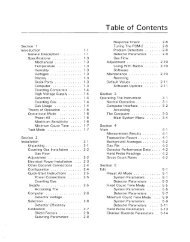PM-7 Operating Manua.. - Voss Associates
PM-7 Operating Manua.. - Voss Associates
PM-7 Operating Manua.. - Voss Associates
You also want an ePaper? Increase the reach of your titles
YUMPU automatically turns print PDFs into web optimized ePapers that Google loves.
Algorithms<br />
Statistical Theory<br />
N A could be converted to a count rate, RA, by dividing it by T, the count<br />
time. The right hand side of Eq. 2.6 would, of course, have to be divided by<br />
T also. If the denominator, T, is placed under the radical it would become<br />
T 2 , but N B(avg) divided by time is also a count rate which will be defined as<br />
RB which is equal to the average background count rate. Thus, Eq. 2.6 can<br />
be expressed in terms of count rates by Eq. 2.7:<br />
N A = SF R -----<br />
B Eq. 2.7<br />
T<br />
The <strong>PM</strong>-7 uses Eq. 2.7 to determine the alarm setpoints (above<br />
background) for the individual detector channels. The analogy of the above<br />
example can be applied to a combined count rate produced in a detector<br />
channel by background plus source activity. With RDA being the level of<br />
source activity of interest, the total count rate produced in the detector<br />
channel would be R B + RDA x eff where eff is the 4-pi efficiency of the<br />
detector. The average count rate produced above average background is<br />
RDA x eff (average). For a given probability of detection, or confidence<br />
level, an alarm setpoint must be selected the appropriate number of “sigma”<br />
below RDA x eff. The multiplier of this sigma is called “z”, and by analysis<br />
can produce Eq. 2.8:<br />
R<br />
R A RDA × eff z B + RDA × eff<br />
= – ------------------------------------- Eq. 2.8<br />
T<br />
The individual detector channels in the <strong>PM</strong>-7 calculate their RDA using Eq.<br />
2.9 and compare that value to MAX RDA to verify that the former is the<br />
lower of the two. If this is not true, the instrument is placed out of service<br />
due to a high background condition. Eq. 2.9 is derived by setting Eq. 2.7<br />
equal to Eq. 2.8 and solving for RDA. Note that Eq. 2.9 is iterative in that<br />
RDA exists on both sides of the equal sign.<br />
RDA<br />
=<br />
SF<br />
R B R<br />
----- z B + RDA × eff<br />
+ --------------------------------------<br />
T<br />
T<br />
----------------------------------------------------------------------<br />
eff<br />
Eq. 2.9<br />
Thermo Fisher Scientific<br />
Personnel Monitor -7 Techical Guide_4-5_













